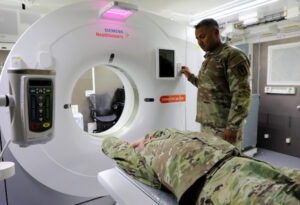U.S. Army Sgt. 1st Class Donald Faustin is a 68P, otherwise known as a Radiology Specialist, and is the Non-Commissioned Officer in Charge (NCOIC) at BDAACH’s Department of Radiology.
As a Radiology Specialist, it is his duty to conduct physical examinations on patients and take X-rays to provide detailed images of the body. He gets patients ready for tests, positions them correctly, runs the machinery, and utilizes his expertise to reduce radiation exposure to the patient.
This requires being specialized in various modalities within radiology such as Computed Tomography (CT), Magnetic Resonance Imaging (MRI), and Sonography (Ultrasound).
BDAACH recently installed a new field-grade CT scanner, simultaneously expanding the hospital’s radiology resources and serving as a training tool for Radiology Specialists like Faustin.
“It’s an opportunity for us to deploy and employ our field radiologic capabilities and provides an alternative means for our Soldiers and personnel to train on our TOE equipment to the same capability,” said U.S. Army Col. Alison Batig, BDAACH Director and 549th Hospital Center Commander.
Having a portable CT scanner also allows for expedited imaging services in the field, ultimately enabling more time for care.
“The CT scanner has increased our capabilities tremendously. It allows us to have eyes inside the body and pinpoints exactly what needs to be done before sending off injured Soldiers to treatment facilities. It’s a total game changer,” said U.S. Army Staff Sgt. Santosh Thapa, a fellow Radiology Specialist and Senior Enlisted Advisor to the Deputy Director for Nursing.
The new CT scanner provides imaging capabilities similar to the CT machine inside the hospital. It serves as a prime example of how operational training is integrated into what they do in the hospital every day.
“When the hospital is set up for it, there will be a way to connect this CT ISO to our systems in the department and we’ll be able to just push everything over there. The idea is that if for some reason the main CT that we have inside goes down, we don’t have to worry about sending patients out. We can just bring them in here to continue,” said Faustin.
“We can do our mission on a regular basis to make sure that we are ready to fight tonight with our current MTOE equipment and using the capabilities we’ll end up having in the field,” said U.S. Army Lt. Col. Audrey Boenker, Commander of 121st Field Hospital.
